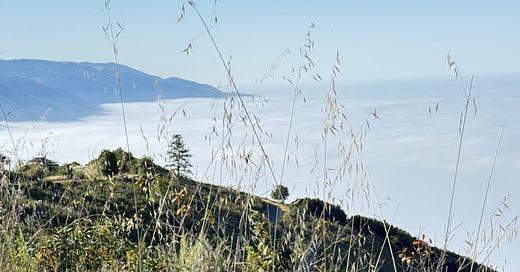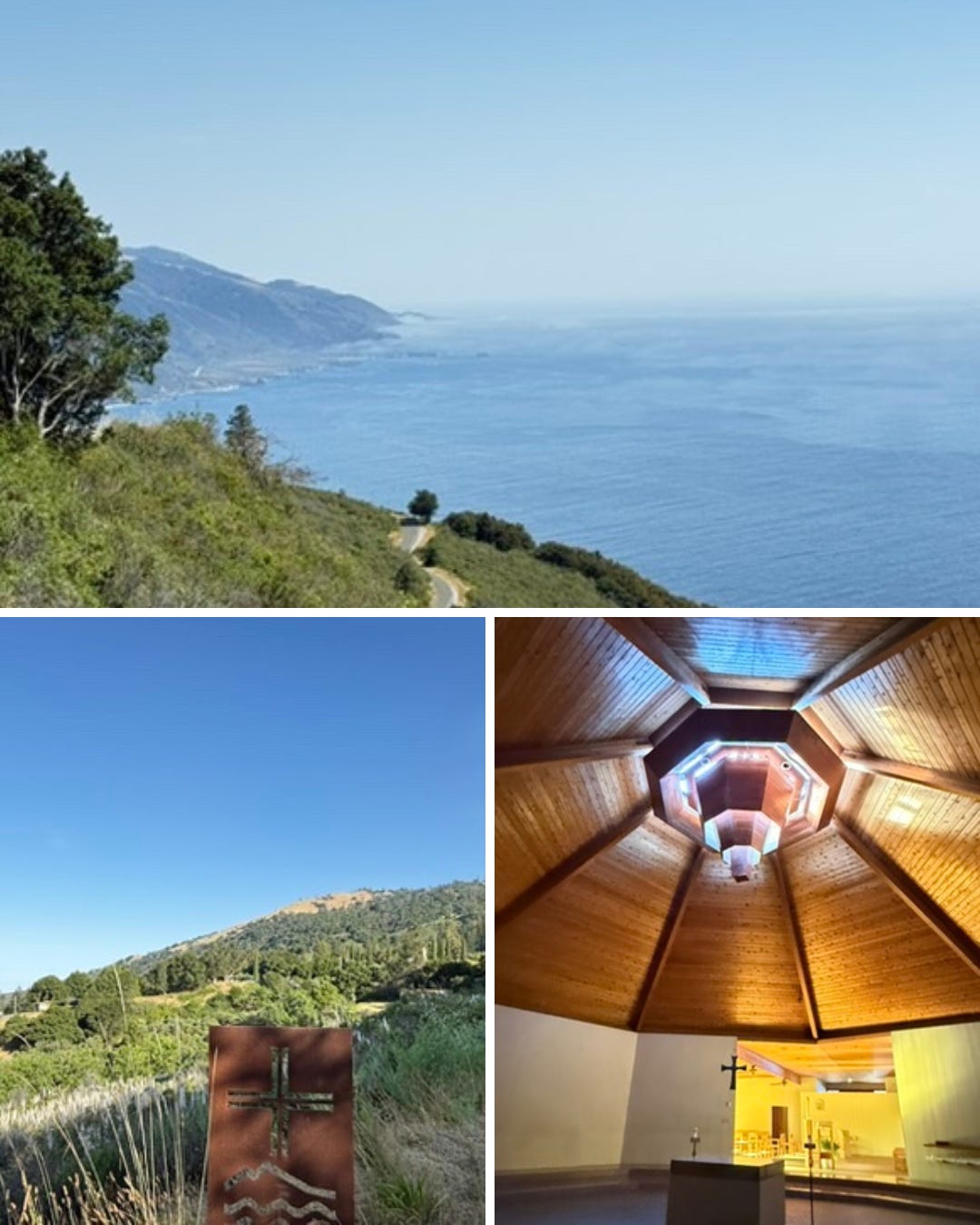When I booked the trip to California, I didn’t expect to find myself weeping in a rotunda on top of a mountain in Big Sur.
I hadn’t even planned to visit a monastery. The New Camaldoli Hermitage had drifted through my awareness earlier that year, when I read Pico Iyer’s Aflame. I remembered underlining a passage about the transformative presence of silence and the beauty of the Hermitage. Still, I hadn’t planned to go—not until Cynthia Bourgeault mentioned it during a session of our Wisdom School. Something lit up in me the moment she spoke its name. I looked it up that evening. They had rooms available. The dates aligned. So I said yes.
The drive up the mountain was long and winding. The views were expansive—cliffs giving way to wide sky, the Pacific sparkling with late afternoon light. It felt like driving deeper into the wilds of the soul, like leaving behind the static of the world. No cell signal. No internet. You shed the noise as you climb. By the time I arrived at the Hermitage, I was already somewhere else entirely.
There was a hush there so complete it felt like another atmosphere. It wasn’t imposed silence—it was the kind that arises naturally, the kind that invites you to match it with your own breath and being.
That first evening, I joined the monks for Vespers. Their chants were slow and steady, an invitation more than a performance. Visitors were encouraged to join in, but I stayed quiet, letting their voices anchor me in something older than language.
After the service, they invited us to thirty minutes of silent prayer in the rotunda. The chapel, octagonal and warm, holds silence like water holds light.
It was two days later—Sunday morning—that the tears finally came.
After Lauds, I asked one of the brothers if I could sit alone in the rotunda before I left. He seemed concerned; the monks had choir practice scheduled, and he didn’t want to disturb my prayer. I smiled and told him that wouldn’t be a problem.
What I didn’t say—what I couldn’t have explained—was that their chanting wasn’t a distraction. It was the final thread. The resonance I didn’t know I was waiting for.
As their voices filled the rotunda, something in me slid quietly into place.
Eight days earlier, I had arrived at the Wisdom School—a gathering rooted in the Rule of St. Benedict and three-centered awareness: head, heart, and body brought into balance through movement, contemplation, and sacred study. I had entered already attuned to those rhythms—I just hadn’t called them spiritual. I hadn’t yet honored how deeply they lived in me.
But that morning, as the chanting rose through the chapel walls and circled the wooden beams above my head, I felt the fullness of it all. My body still, my breath deep, my heart open.
This was not an escape. This was a return.
And I had built a life that allowed me to come home to myself in this way.
The tears came not from sadness or longing, but from the quiet joy of recognition.
This is the life I’ve made.
This is the rhythm I’ve chosen.
And it fills my heart.
What surprised me most—driving down the mountain, descending through fog back into the “real” world—was realizing just how much of my business had been quietly shaped by these same principles. Not by a productivity model or a formal plan, but by the deep hum of what felt true. The way I guide clients, the kinds of offers I create, the refusal to separate sacred living from strategic action—all of it arises from this same center. From listening with the heart.
Years earlier, there had been another kind of monastery moment—less silence, more socks.
It was during a retreat at the National Cathedral in Washington, D.C., when the Bishop of Palestine arrived without his luggage. The retreat staff bustled and fussed, eager to impress him. At some point, someone asked me to keep him company while they sorted things out. He was gracious but clearly frustrated. After a few phone calls to embassies and the airport, he sighed and said, “If I had a car, I’d just go get my luggage myself.”
“I have a car,” I said. “I’ll take you.”
That raised a few eyebrows. One participant asked why I would skip the cathedral’s night tour for something so mundane. But my heart had already said yes.
In the end, we didn’t go to the airport. Another attendee suggested Target would be a better choice, and the Bishop agreed. And just like that, I found myself climbing into my little two-door Saturn with the Bishop of Palestine and the Bishop of London, who arrived just in time to join us.
They were like schoolboys on an adventure—chattering away, delighted by the absurdity of it all.
We bought underwear, socks, and an extra shirt. The Bishop of London kept the mood light, pointing out garish ties and novelty shirts with a twinkle in his eye, offering up increasingly ridiculous options “for the Bishop’s American tour.” At checkout, I helped him with the credit card machine, which was unfamiliar to him. On the drive back, he asked if I’d help him with his laundry. He knew how to iron, but he had never used an American washing machine.
That evening, we spent hours in the retreat center's basement—washing and folding his new clothes, discussing leadership. He spoke of Yasser Arafat—not the version painted in the press, but the one who, in his words, “deeply loved his people.” The leaders he admired most weren’t those with the most power or position, but the ones who led with dignity and compassion. The ones who truly cared for their flocks.
Before we parted, I told him I planned to meet friends to watch a meteor shower later that night. He asked if he could join us. Of course, I said.
And so we stood under the stars, shoulder to shoulder, watching light streak the sky.
The next morning, he served me breakfast.
It wasn’t showy. It wasn’t symbolic. It was a small, real act of gratitude. A returning of service, offered in the quiet way that means the most.
Weeks later, he sent me a rosary, a few small treasures, and a handwritten note of thanks.
Moments like that have stayed with me. They inform how I show up in my work, in my life—not just as a strategist or consultant, but as a human being in relationship with others. Business, at its best, is nothing more than an ongoing series of choices about how we care for one another—with dignity, with compassion, with presence. We lead not by authority, but by attention to the hearts of others.
Sometimes the holiest thing you can do is say yes to the moment that asks for your presence.
These are the moments I return to when I think about what it means to live a sacred life. Not one removed from the world—but one attuned to it. One that gives you the freedom to listen to the ear of your own heart and to say yes when it matters.
I used to think freedom meant an open calendar, long stretches of unstructured time. But it’s not about time, really. It’s about integrity—a continuity between your soul and your choices. And yes, that includes your work.
That’s what the Wisdom School clarified for me. That’s what the Hermitage affirmed. And years ago, that’s what the Bishop reminded me—sometimes sacred living looks like laundry, laughter, and a meteor shower shared under the stars.
And that’s what I carry now, into the daily rhythm of my life and business.
The monastery isn’t just on a mountaintop in Big Sur.
It’s in the way I build programs and offers.
It’s in the way I listen to clients.
It’s in the shape of decisions made from the center—not from fear, not from urgency, but from resonance.
The sound of the monastery, it turns out, lives inside the work too.
And when we let that sound guide us, the work becomes more than strategy—it becomes devotion.
It becomes the shape of a life that listens with the ear of the heart, moves with three-centered awareness, and honors purpose not as a goal, but as a way of being.
Reflection: Listening with the Ear of the Heart
Take a few quiet moments after reading this chapter to let your own memories rise. The following questions aren’t meant to be answered quickly—they’re invitations to notice what stirs. Take what resonates and leave behind what doesn’t.
When was the last time you felt yourself in complete alignment—mind, body, and heart all saying yes? What were the conditions that allowed that moment to unfold?
What does freedom look like for you—not the fantasy version, but the kind that lets you act on what truly matters?
Where in your life are you being invited to pause, or to serve, or to change your plans—not out of obligation, but out of resonance?
If you listened today with the ear of your heart—what would you hear? What does it have to say about your own rhythm?
You might want to write your responses, speak them aloud, or simply let them echo quietly in your awareness throughout the day.











More and more you're on the right track!
Beautiful, Carmen. What a gift you have. Thank you.